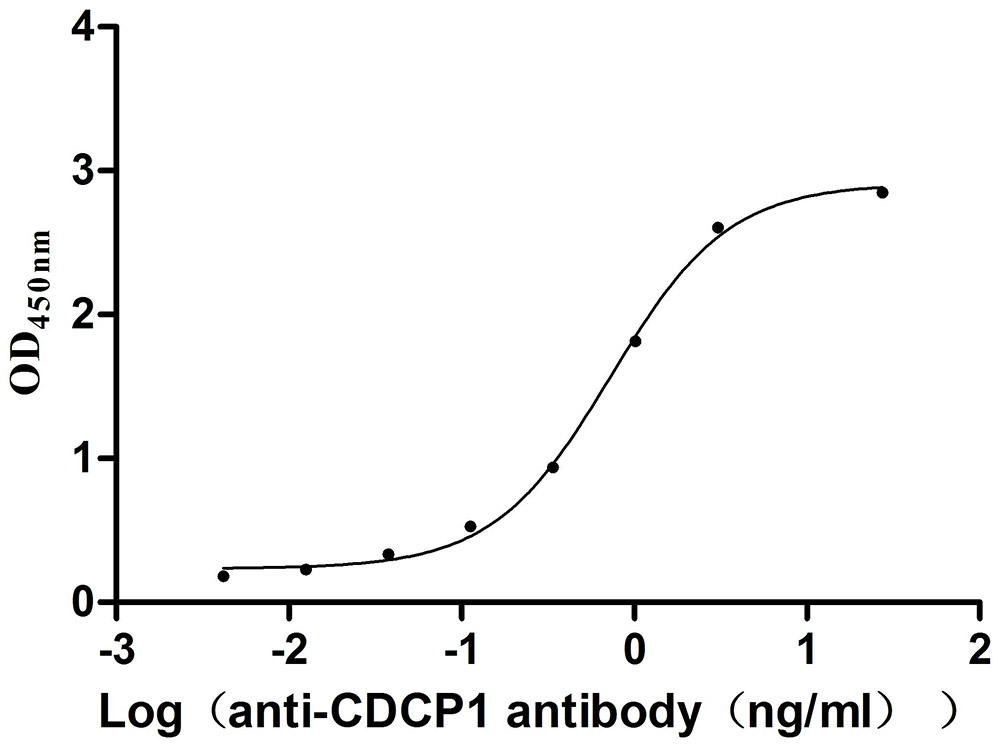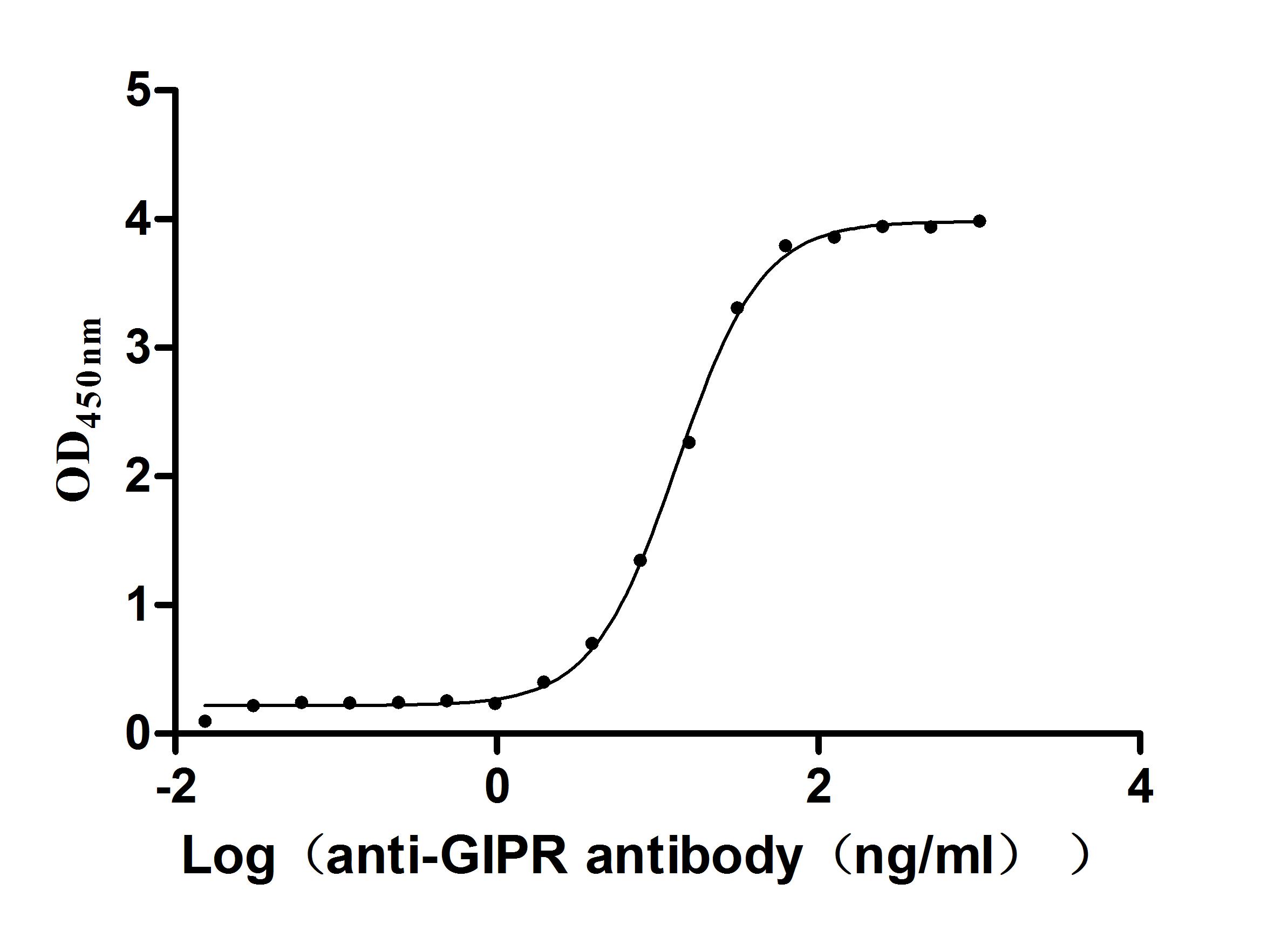Recombinant Mouse B-cell receptor CD22 (Cd22), partial
-
货号:CSB-YP004900MO
-
规格:
-
来源:Yeast
-
其他:
-
货号:CSB-EP004900MO
-
规格:
-
来源:E.coli
-
其他:
-
货号:CSB-EP004900MO-B
-
规格:
-
来源:E.coli
-
共轭:Avi-tag Biotinylated
E. coli biotin ligase (BirA) is highly specific in covalently attaching biotin to the 15 amino acid AviTag peptide. This recombinant protein was biotinylated in vivo by AviTag-BirA technology, which method is BriA catalyzes amide linkage between the biotin and the specific lysine of the AviTag.
-
其他:
-
货号:CSB-BP004900MO
-
规格:
-
来源:Baculovirus
-
其他:
-
货号:CSB-MP004900MO
-
规格:
-
来源:Mammalian cell
-
其他:
产品详情
-
纯度:>85% (SDS-PAGE)
-
基因名:
-
Uniprot No.:
-
别名:Cd22; Lyb-8; Siglec2; B-cell receptor CD22; B-lymphocyte cell adhesion molecule; BL-CAM; Sialic acid-binding Ig-like lectin 2; Siglec-2; T-cell surface antigen Leu-14; CD antigen CD22
-
种属:Mus musculus (Mouse)
-
蛋白长度:Partial
-
蛋白标签:Tag type will be determined during the manufacturing process.
The tag type will be determined during production process. If you have specified tag type, please tell us and we will develop the specified tag preferentially. -
产品提供形式:Lyophilized powder
Note: We will preferentially ship the format that we have in stock, however, if you have any special requirement for the format, please remark your requirement when placing the order, we will prepare according to your demand. -
复溶:We recommend that this vial be briefly centrifuged prior to opening to bring the contents to the bottom. Please reconstitute protein in deionized sterile water to a concentration of 0.1-1.0 mg/mL.We recommend to add 5-50% of glycerol (final concentration) and aliquot for long-term storage at -20℃/-80℃. Our default final concentration of glycerol is 50%. Customers could use it as reference.
-
储存条件:Store at -20°C/-80°C upon receipt, aliquoting is necessary for mutiple use. Avoid repeated freeze-thaw cycles.
-
保质期:The shelf life is related to many factors, storage state, buffer ingredients, storage temperature and the stability of the protein itself.
Generally, the shelf life of liquid form is 6 months at -20°C/-80°C. The shelf life of lyophilized form is 12 months at -20°C/-80°C. -
货期:Delivery time may differ from different purchasing way or location, please kindly consult your local distributors for specific delivery time.Note: All of our proteins are default shipped with normal blue ice packs, if you request to ship with dry ice, please communicate with us in advance and extra fees will be charged.
-
注意事项:Repeated freezing and thawing is not recommended. Store working aliquots at 4°C for up to one week.
-
Datasheet :Please contact us to get it.
靶点详情
-
功能:Mediates B-cell B-cell interactions. May be involved in the localization of B-cells in lymphoid tissues. Binds sialylated glycoproteins; one of which is CD45. Preferentially binds to alpha-2,6-linked sialic acid. The sialic acid recognition site can be masked by cis interactions with sialic acids on the same cell surface. Upon ligand induced tyrosine phosphorylation in the immune response seems to be involved in regulation of B-cell antigen receptor signaling. Plays a role in positive regulation through interaction with Src family tyrosine kinas...显示更多
-
基因功能参考文献:
- Thus, proximity labeling with tyramide appears to be a useful method to identify cis-ligands and to analyze their interaction with the lectins. PMID: 29146181
- This combined approach suggests that the inhibitory function of CD22 is influenced by its nanoscale organization and is ensured by its fast diffusion enabling a "global BCR surveillance" at the plasma membrane. PMID: 26671981
- results demonstrate that loss of high affinity CD22 ligands on GC B-cells occurs in both mice and humans through alternative mechanisms, unmasking CD22 relative to naive and memory B-cells PMID: 26507663
- A noncatalytic role for CD45 in regulating tonic, but not antigen-mediated, B-cell antigen receptor (BCR) signaling through modulation of the function of the inhibitory coreceptor CD22, was identified. PMID: 26561584
- CD22 is recruited to the immunological synapse by sialic acid ligands on the Ag-bearing cells, producing a tolerogenic signal involving Lyn and the proapoptotic factor BIM that promotes deletion of the B cell and failure of mice to develop Abs to the Ag upon subsequent challenge. PMID: 25252961
- These data assign a key role to CCL22 in Treg recruitment in the protection of NOD mice against type 1 diabetes following the treatment with G-CSF. PMID: 23878314
- Thus, CD22 plays an essential role in controlling West Nile virus infection by governing cell migration and CD8(+) T cell responses. PMID: 23302871
- that neither B cells nor CD22 are critical for the immediate antiinflammatory activity of IVIgs in mouse models of rheumatoid arthritis and ITP. PMID: 22945870
- Increased red cell turnover in a line of CD22-deficient mice is caused by Gpi1c: a model for hereditary haemolytic anaemia. PMID: 22930244
- novel expression pattern and tissue eosinophilia-regulating function for the "B cell-specific" inhibitory molecule CD22 on GI eosinophils. PMID: 22190185
- As a receptor for sIgM, CD22 induces a negative feedback loop for B-cell activation/ PMID: 21956693
- The efficacy of a ligand-targeting approach to B cell-specific depletion therapy for cancer may be the ability of CD22 to recycle and accumulate ligand-decorated cargo intracellularly, as an endocytic receptor. PMID: 21178016
- It regulates B lymphocyte signaling. (review) PMID: 21089380
- CD22 and BLyS promote the survival of overlapping B-cell subsets but contribute to their maintenance through independent and complementary signaling pathways PMID: 20513733
- CD22 deficiency results in prolonged contact hypersensitivity (CHS) reactions and suggests an inhibitory role for CD22 expression, especially during the late phase in elicitation of CHS. PMID: 20335532
- Siglec-G and CD22 have partly compensatory functions and together are crucial in maintaining the B cell tolerance. PMID: 20200274
- Decoration of T-independent antigen with ligands for CD22 and Siglec-G can suppress immunity and induce B cell tolerance in vivo. PMID: 20038598
- Data show that anti-CD22 autoantibodies were positive in 80% of TSK/+ mice and in 22% of SSc patients. PMID: 19919568
- The Lyn/CD22/SHP-1 pathway is important in autoimmunity. Naive and tolerant B-cells differ in their calcium signaling in response to antigenic stimulation. PMID: 11826756
- sialic acid binding domains are necessary for CD22 to function as a negative regulator PMID: 11994425
- The expression and function of CD22 are differentially regulated in B-1 and conventional B-2 lymphocytes, which are implicated in innate and adaptive immunity, respectively. PMID: 12055217
- CD22 binding to native CD45 and synthetic oligosaccharide PMID: 12115612
- Surface expression of CD22 is selectively increased on B lineage cells in the bone marrow of BOB.1/OBF.1-deficient mice AND regulates early B cell development. PMID: 12207332
- In the yeast two-hybrid system the carboxyl-terminal portion of the CD22 cytoplasmic tail, encompassing tyrosine residues 843 and 863, is critical for binding of clathrin adaptor AP50 to CD22, an interaction required for internalization. PMID: 12646615
- Inhibitory coreceptors CD22 and CD72 are responsible for setting the requirement of CD40 signaling for survival and proliferation of antigen-stimulated spleen B cells. PMID: 12902484
- CD22 is an inhibitory coreceptor for B cell receptor (BCR) signaling. The inhibition is most likely mediated by activation of SHP-1. PMID: 14635051
- CD22 neither associates with nor functions in major histocompatibility complex (MHC) class II/Ig-alpha beta signaling, and is actively excluded from cell surface MHC class II aggregates. PMID: 14688326
- CD22 is defined as a critical regulator of B cell proliferation, survival, phenotype, and the expression of essential cell cycle regulatory genes, especially in the context of a C57BL/6 genetic background. PMID: 14764675
- reduced Marginal Zone B cell compartment in the absence of CD22 expression does not interfere with the inflammatory response during S. aureus arthritis and sepsis. PMID: 15050965
- Neurons secrete CD22, which functions as an inhibitor of microglial proinflammatory cytokine production. PMID: 15095367
- Results suggest that CD22 is expressed on mouse primary T cells and capable of associating with the Src homology 2 domain-containing protein-tyrosine phosphatase, SHP-1. PMID: 15364920
- CD22 regulates B lymphocyte function in vivo through both ligand-dependent and ligand-independent mechanisms. PMID: 15378059
- knock-out mice have increased numbers of B-1 cells, BCR signalling hyperesponsiveness, develop autoimmune disease-like manifestations, genetic polymorphisms may contribute to autoimmunity PMID: 16227086
- deficiencies in both CD22 and its ligand (Cd22-/- St6gal1-/- mice) showed restored B cell receptor (BCR) signaling, suggesting that the suppressed signaling of St6gal1-/- cells is mediated through CD22 PMID: 16369536
- negative role of CD22 in CD40 signaling PMID: 16393971
- Protein glycosylation by ST6Gal-I restricts access of antigen receptors and Shp-1 to CD22 and operates by a CD22-dependent mechanism. PMID: 16782884
- inhibition of CD22 ligand binding can disrupt normal and malignant B cell survival in vivo and suggest a novel mechanism of action for therapeutics targeting CD22 ligand binding domains PMID: 16920943
- gamma1 chain can exert a unique signaling function that can partially replace that of the Ig alpha/beta heterodimer in B cell maintenance and may contribute to memory B cell physiology PMID: 17420268
- strongly suggest that synthetic glycan ligand excludes CD22 from BCR-containing lipid rafts PMID: 17631277
- These immunoreceptor tyrosine-based inhibition motifs constitute a novel conditional SHP-1-binding site of CD22 that is activated upon BCR ligation by antigen but not by anti-Ig Ab. PMID: 18024433
- B cells deficient in the inhibitory coreceptor CD22 undergo accelerated cell division after Ag stimulation, resulting in rapid generation of plasma cells and Ab production. PMID: 18178830
- second CD22 ligand (CD22L) is expressed on CD11c(+) splenic and bone marrow-derived dendritic cells PMID: 18354178
- SAP is expressed endogenously in mouse splenic B cells and co-localizes and interacts with CD22. SAP binding to the inhibitory immunoreceptor CD22 regulates calcium mobilization in B cells. PMID: 19150402
- Inhibition of B cell receptor signaling by Lyn kinase-CD22-Src homology region 2 domain-containing phosphatase-1 (SHP-1) pathway is up-regulated as splenic B cells mature, and is involved in maintenance of peripheral B-cell immune tolerance. PMID: 19380785
收起更多
-
亚细胞定位:Cell membrane; Single-pass type I membrane protein.
-
蛋白家族:Immunoglobulin superfamily, SIGLEC (sialic acid binding Ig-like lectin) family
-
组织特异性:B-lymphocytes.
-
数据库链接:
KEGG: mmu:12483
STRING: 10090.ENSMUSP00000019248
UniGene: Mm.260994




















